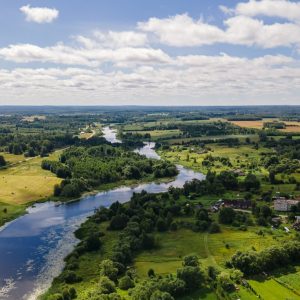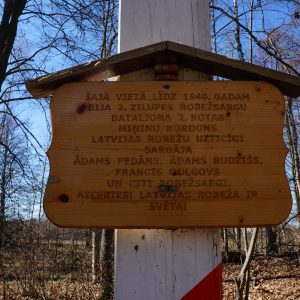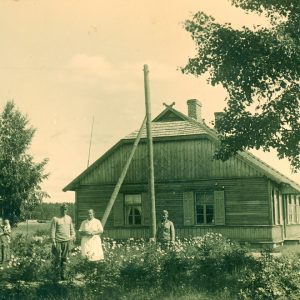
In this audio guide, you'll learn about the guardians of border along Latvia’s eastern border in Latgale – the border guards. You’ll discover what their daily lives were like between the founding of the Latvian state in 1918 and the Soviet occupation in 1940.
Today, thanks to modern technology, border surveillance might seem relatively straightforward. But hundred years ago, guarding the border was a serious challenge that demanded not only physical endurance but also great courage and a strong sense of responsibility. Back then, border guards had to rely entirely on their own skills, experience, and teamwork to protect the country – often in remote and difficult terrain.
It’s important to remember that borders are not just geopolitical lines. They are also home to real people, with their own social lives, cultures, and livelihoods.
We hope these stories will help you appreciate the dedication, professionalism, and bravery of Latvia’s border guards, past and present.

Over the years, the protection of Latvia’s borders has undergone several important changes in structure and responsibility, reflecting the country’s shifting domestic and international realities.
Following Latvia’s declaration of independence in 1918 and the restoration of independence in 1990, guarding the national border became a key task in ensuring the sovereignty and territorial integrity of the state. The border was both a symbol and a practical expression of Latvia’s independence, fostering a sense of belonging among its people – to their country, its values, and its goals.
In the early years after gaining independence in 1919, border security was handled by the Latvian army. Defining and internationally recognizing Latvia’s borders took time – border treaties were signed with Russia and Estonia in 1920, and with Lithuania in 1921. The border with Poland, however, remained without a formal agreement until the outbreak of the World War II.
Throughout the interwar period, Latvia’s approach to border protection evolved in response to changing political and military conditions. Marking the borders on the ground, building border infrastructure, and creating official border descriptions continued until 1930 to ensure clarity and the integrity of state territory.
In 1928, as threats from the Soviet Union increased, new regulations were issued to strengthen the border. By 1935, Latvia’s Border Guard had become fully militarized, ready to defend the country against external threats.
Border protection units were divided into battalion areas, effectively covering Latvia’s borders with the USSR, Lithuania, Estonia, and the coastline. Particularly important were the three battalions assigned to the 351-kilometre stretch along the Soviet border – including the Zilupe Battalion in the Ludza District, which had the largest number of border guards.
The Zilupe Battalion was the biggest, consisting of four companies with 12 platoons, 40 guards, and 339 soldiers. To ensure mobility, all officers were assigned riding horses, and each company had utility wagons for transport and supplies. This structure and equipment allowed the border guards to carry out their duties effectively, especially in the demanding frontier zones.
In total, the Latvian Border Guard Brigade included around 100 officers and 1,200 soldiers and instructors. Of these, approximately 919 men were assigned to guard the Latvian–Soviet border, which was considered the most dangerous. At the time, the border between Latvia and the Soviet Union was tightly sealed, and cross-border traffic was limited to just three railway lines.

From 1935 to 1940, under the leadership of Colonel Ludvigs Bolšteins – an outstanding commander and patriotic leader – the Latvian Border Guard experienced a true period of flourishing. New buildings were constructed for border guards and their families, solid and beautifully furnished homes often surrounded by gardens and nurseries.
During Bolšteins’s leadership, border guards actively participated in the cultural and sports life of local communities. They organized events, built stadiums, and even established schools. The professionalism and quality of the border guard service reached new heights. Cultural activities included the construction of community centers, which had electric lighting, halls with film projectors and pianos.
In Krivanda, at the site of the former guard post, the original living quarters are no longer standing – they were burned down by partisans. Only the stone staircase and foundation remain from the once magnificent community center, known for its richly painted walls and ceilings. However, several other buildings have survived, including the border guard store, horse stables, and residential houses.
Thanks to the memories of Lidija Kurcenbauma, wife of a border guard Arvīds Kurcenbaums, we can vividly imagine what life was like for border guards in those times: “The border guards lived in harmony with the locals. Many even married local girls. I met Arvīds in 1940, and we married on June 16th. A state of war had already been declared, but Arvīds was granted two hours leave so we could have our wedding in church and sit down for a simple meal. The border guard stations were beautifully maintained – clean, flowerbeds, ornamental shrubs, and solid buildings.
The Krivanda post had a stunning community center with murals, elegant stairs, rose gardens, and greenhouses for seedlings. They grew fruit trees and bushes, as well as vegetable plants like tomatoes, not only for themselves but to share with local farms.
They held Christmas celebrations with decorated trees and candy for children, hosted balls with orchestras that drew guests even from other districts. They built schools and sports fields, staged theatre performances.
The post had cozy homes and a store where you could buy everything – sausages, cheese, dishes, fabrics, clothes. In the stable, well-kept horses were kept for riding, but they also used bicycles and skis in winter.
Home economics courses were offered to border guards’ wives and local women – they learned to cook, bake cakes, and prepare preserves for winter.
Though there were certain restrictions near the border, everyone lived peacefully. The border guards helped a lot and did good work in the region.”
But everything changed on June 15, 1940, when coordinated attacks were launched against Latvian border guard posts – including the tragic attack on the Masļenki post, where soviet secret police troops killed both guards and civilians. The guards and their families were surrounded, and the brutal assault marked the beginning of the end for Latvia’s independence.
The attack on Masļenki was carried out by NKVD operatives who killed guards and civilians alike. Dozens of people, including children, were taken prisoner and forced across the border into the Soviet Union. The guards, positioned by the Ludza River, were encircled, with no chance of escape – telephone lines had been cut. To hide the evidence of their crimes, the attackers set the post buildings on fire. Soon after, similar assaults were launched against other posts.
The Masļenki tragedy became a powerful symbol of Latvia’s loss of freedom and the Soviet Union’s ruthless aggression. It was a messenger of the occupation that officially began the next day, when the USSR issued an ultimatum to Latvia and began a 50-year-long occupation. Colonel Ludvigs Bolšteins – one of Latvia’s most respected Border Guard commanders – met his fate in the shadow of these events. His final letter reflected unwavering loyalty to Latvia: “We Latvians have built a tall, proud building – our own country. A foreign power now demands that we tear it down with our own hands. I cannot take part in that.”
Soon after, on October 3, 1940, Soviet People’s Commissar Alfons Noviks signed an order to disband all four battalions of the Latvian Border Guard Brigade and dismiss the border guards stationed along the eastern frontier...

After the restoration of Latvia’s independence on May 4, 1990, one of the most important tasks was the re-establishment and protection of the national borders.
The restoration of the Border Guard was based on voluntary service, and people actively applied to join. A special commission in Riga and other cities throughout Latvia evaluated the applications, and by December 1991, approximately 900 border guards had been recruited.
Training took place in several centers, the most enduring of which was the training center in Rēzekne. Over time, this evolved into the State Border Guard College. Today, it remains the only institution in Latvia where one can obtain professional qualifications as a border guard.
December 13, 1991, is considered the official date of the Border Guard’s restoration.
Today, the Latvian Border Guard is one of the key national security institutions. Its mission is not only to ensure the inviolability of the national border but also to monitor and manage migration processes. Since Latvia’s accession to the European Union and the Schengen Area in 2007, the role of the Border Guard has evolved significantly. The importance of border protection has grown, especially in light of securing the EU’s external borders and responding to migration crises.
Now The Latvian Border Guard cooperates closely with the European Border and Coast Guard Agency – Frontex – to strengthen EU security systems and carry out coordinated actions with other NATO member states. The Border Guard employs advanced equipment and technology, including drones, thermal imaging devices, biometric systems, night vision tools, and specially equipped vehicles.